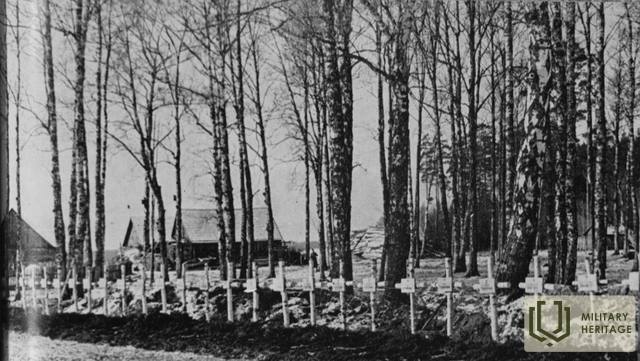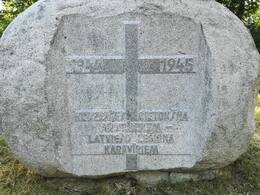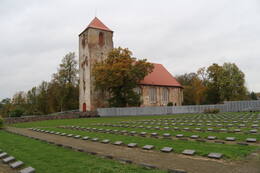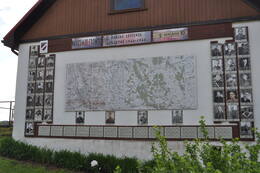Lahing Kurzeme linnuses Lestene lähedal
Jutustaja kirjeldab oma muljeid lahingutest Lestene ümbruses ja Läti 19. diviisi rolli lahingutes.
“(..) Pärast viit suurt lahingut usuvad Kurzeme kaitsjad, et raskeim on selja taga, mistõttu seisatakse kindlalt oma positsioonidel, et Saksamaa kapitulatsioon ei jätaks kasutamata võimalust kodumaa vabastamiseks.
Paljud kahtlusalused on üksuste juurde tagasi pöördunud, kuid uusi võitlejaid taotleb endiselt nii Kuramaa elanike kui ka põgenike seast. Saksamaalt on täiendamisele saadetud ka mitu tuhat Läti sõdurit.
14. märtsil lähen 43. rügemendi staapi, kus pean raporteerima. Teel kohtan kindral Bangerskit, kes on jõudnud Kurzemesse. Tundub, et ka vana sõdur usub rohkem kui kunagi varem, et meie riigile on lähenemas väga otsustav hetk, seetõttu hoiab ta ka oma staapi Kuramaas. Kindral tuletab mulle meelde, et seitsmekordse haavatuna, kes on oma varanduse ammendanud, pean minema tema juurde komandöriks. Seda tuleb muidugi veel jaoülemaga arutada.
Rügemendi staabis käib segadus. Rügemendi ülem kolonel Osis lahkub rügemendist. Major Reinholds võib igal ajal ilmuda ja võtab rügemendi juhtimise üle. Nii langes tema armu alla veel üks kolonel. Esimene nelja kuu jooksul oli Lobe.
Reinhold on lõpuks kohal ja võtab rügemendi üle. Mind määratakse pataljoni kapten Bumbieriks kompanii ülemaks. Ornament on puhkeseisundis ja reserveeritud pataljoni staabis. Pataljoni ülema asetäitja vanemleitnant Jaunzems on vana lahinguhunt ja teab rinde seisust üksikasjalikult rääkida. Enamlased on Lestene koolis, kust on meie asukohale künka pealt hea vaade, nii et kohe, kui väikseimgi seltskond välja ilmub, avavad nad tule granaadiheitjate pihta.
"Ei, see ei saa nii jääda," hindame ja vaatame rünnaku suunda, et venelased koolist välja visata.
Lestene ise on põhilahinguliinil. Peale minu on ainult üks ohvitser - leitnant Zutis. Ka meeste arv ehetes jääb alla saja. Bolševistlikud kõnelejad helistavad iga päev relvad maha panema, räägivad Riiast. Siin räägib Lilita Bērziņa, siin räägib Lācis ja siin räägib teine avaliku elu tegelane.
Ööl vastu 16.-17.märtsi asendavad meid Saksa üksused ja oleme teel uutesse kaevikutesse, kuhu vaenlane on sissetungi teinud. 19. diviis, kui võiks öelda, täidab Kurzemes tuletõrjuja rolli - kus toimub, seal peavad läti mehed kiirustama ja korda looma. (..)
Avaldatud USA-s Daugava Hawksi kuukirjas. Leitnant Roberts Ancānsi mälestused lahingutest Kurzemes "Sõdur räägib"
Seotud ajajoon
Seotud objektid
Kurzeme kindlustuse kaitsjate mälestuskivi
Asub Tukumsi piirkonnas, kiirtee A9 ääres, pöördest Lestenisse Riia suunas 500 m.
Mälestuspaik rajati 1991. aastal Rumbu majade juurde, mille ümbruses käis aktiivne sõjapidamine. See on austusavaldus II maailmasõjas Punaarmee vastu võidelnud "Kurzeme kindluse" kaitsjatele. Lahingud olid märkimisväärsed, kuna peatasid ajutiselt Läti täieliku okupeerimise Punaarmee poolt. Umbes 300 000 lätlast emigreerus, vältides Nõukogude režiimi kuritegusid tsiviilelanikkonna vastu.
Teise maailmasõja lõpus oli Läti territooriumil kujunenud omapärane olukord. Kurzemes olid Saksa armee väed, mida Punaarmee püüdis likvideerida või takistada nende osalemist lahingutes Ida-Preisimaal või Berliini ümbruses. "Kurzeme kindlus" - kõige levinum termin Kurzeme sõjapidamise kirjeldamiseks aastatel 1944–1945. "Kurzeme lahingud" olid Saksa armee lahingud Punaarmee ulatuslike rünnakute tõrjumiseks. Kurzeme kindlus lakkas eksisteerimast varsti pärast Saksa kapitulatsiooni.
Täna saab näha mälestus- ja puhkepaika, mis on olnud Läti leegionäride seas populaarne alates Läti taasiseseisvumisest.
Lestene luteri kirik
Asub Tukumsi oblastis Lestenes kiriku kõrval.
Vennaskalmistu ehitamine Lestenes algas 1998. aastal. Tegemist on suuruselt teise sõdurite kalmistuga Lätis, kuhu on koos maetud üle 1300 Läti leegionäri. Alles pärast Läti Vabariigi taastamist oli võimalik matta erinevatest kohtadest II maailmasõjas langenud Läti sõdureid.
Läti Leegion oli peamiselt illegaalselt mobiliseeritud lätlastest moodustatud Saksa armee lahinguüksus. Sõdurid tajusid oma kohalolekut leegionis võitlusena Läti iseseisvuse taastamise eest, vaatamata sellele, et see toimus Saksa relvajõudude ridades ja et Saksamaa oli Läti okupeerinud. Polnud ühtegi teist sõjalist jõudu, mis oleks suutnud Nõukogude okupatsiooni naasmist edasi lükata. Läti leegionärid võitlesid Punaarmee vastu, kes oli kaotanud Läti iseseisvuse, hävitas selle armee ja sooritas kuritegusid tsiviilelanike vastu. Saksa armee ridades võitles 110 000–115 000 sõdurit, neist 30 000–50 000 lahkus lahinguväljal.
Lestenes saab täna näha Vennaskalmistut, mille kõrval asub Lestene kirik. See on barokse sakraalkunsti silmapaistev näide. Vanas kirikupubis saab tutvuda Läti Leegioni ajaloole pühendatud ekspositsiooniga. Vennaskalmistu keskse kujutise "Emamaa – ema – Läti" lõi skulptor Arta Dumpe. Lähedal asub Lestene mõis, mis enne Teist maailmasõda kuulus Läti armeekindral Mārtiņš Hartmanisele.
Ekskursioone Lestene kirikusse saab broneerida Lestene Evangeelse Luterliku Kiriku koguduse juhataja Inguna Kokina, tel +371 29993743.
Lestene vennaskalmistu, mälestusnäitus ja punker
Lestene vennaskalmistu asub Tukumsi piirkonnas Lestene kiriku kõrval. Lestene vennaskalmistu rajamist alustati 1998. aastal. See on Läti suuruselt teine sõdurikalmistu, kuhu on maetud üle 1300 läti leegionäri. Alles pärast Läti Vabariigi taasiseseisvumist oli võimalik Teises maailmasõjas langenud läti sõdureid ümber matta. Läti leegion oli Saksa armee lahinguüksus, mis moodustati peamiselt ebaseaduslikult värvatud Läti elanikest. Hoolimata sellest, et leegionärid kuulusid Saksa relvajõudude ridadesse ja Saksamaa oli Läti okupeerinud, pidasid sõdurid oma leegionis teenimist Läti iseseisvuse taastamise eest võitlemiseks. Läti leegionärid võitlesid Punaarmee vastu, mis oli hävitanud Läti iseseisvuse ja sõjaväe ning pannud toime kuritegusid tsiviilelanike vastu. Saksa armee ridades võitles 110 000–115 000 sõdurit, kellest umbes 30 000–50 000 jätsid oma elu lahinguväljale. Vennakalmistu keskse teema „Kodumaa – ema – Läti“ on loonud skulptor Arta Dumpe. Üle tee asuvas endises kõrtsihoones on välja pandud Läti leegioni ajaloole pühendatud näitus. Kohe selle kõrvale on Läti Ohvitseride Ühingusse kuuluvad mehed kapten Jānis Slaidiņši juhtimisel ehitanud maa-aluse punkri, et näidata, kuidas sõdurid ja ohvitserid rindel elasid.









